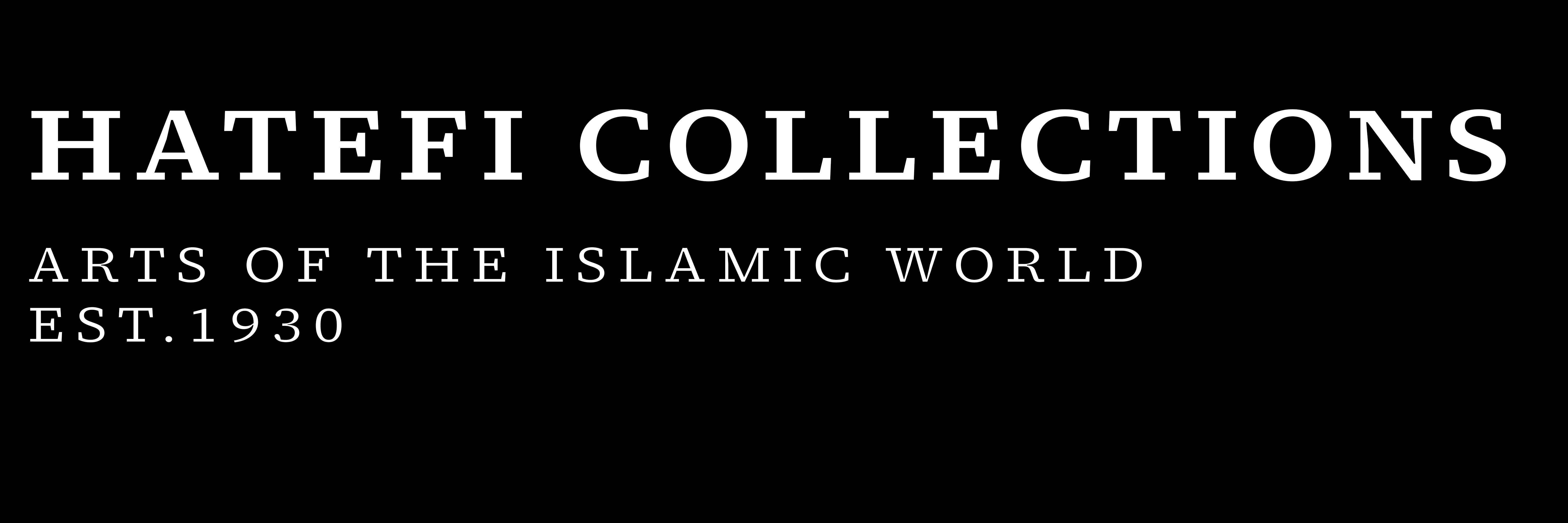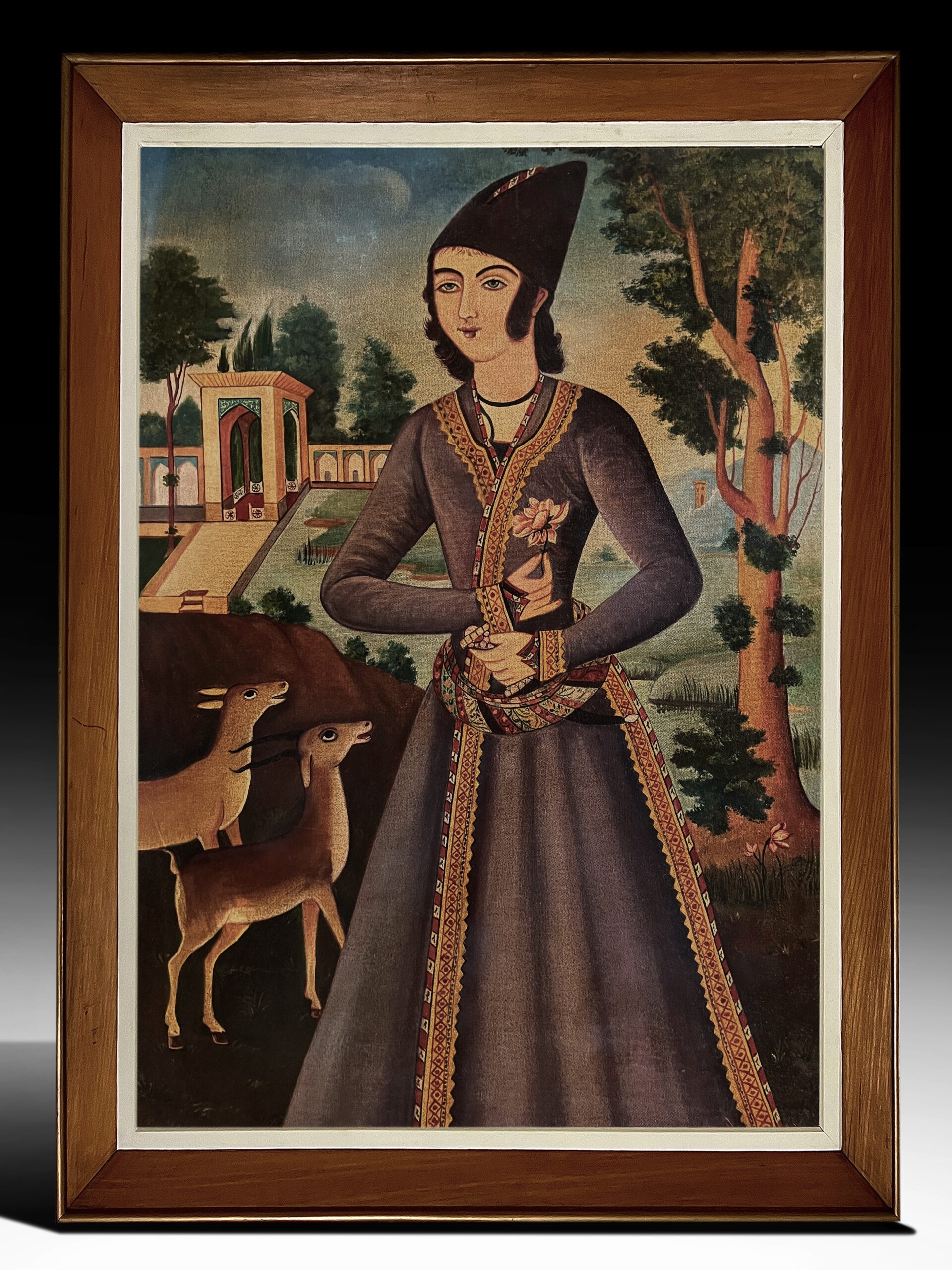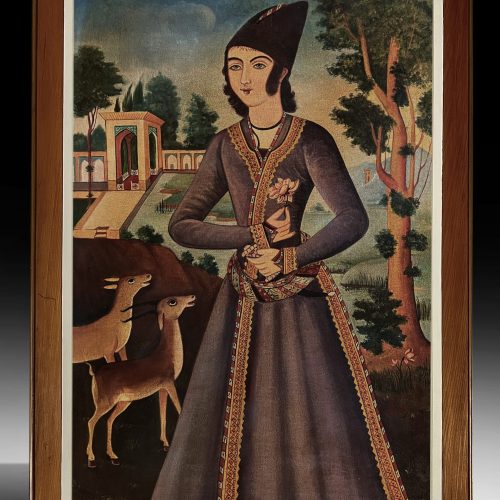IN A STYLE QAJAR OIL PAINTING OF HAZRAT-E-YUSUF WITH GAZELLES
PERIOD | 1994 |
|---|---|
ORIGIN | Persia |
DIMENSIONS: | 100×70 Cm |
DESCRIPTION: | Being placed in front of cheerful Hazart-e-Yusef grasping a single flower in the open Persian Royal Garden with two gazelles heading upwards and gazing at Hazrat-e-Yusef, in the background exquisite Qajaric Royal Palace on a raised platform, the frame is not included.This frame has been used for display purposes “ONLY”, |
FOOTNOTES: | Qajar Artworks, are the portraits that were made of the various Persian Shahs. Each ruler, and many of their sons and other relatives, commissioned official portraits of themselves either for private use or public display. The most famous of these are the myriad portraits which were painted of Fath Ali Shah Qajar, who, with his narrow waist, long black bifurcated beard and deepest dark eyes, has come to exemplify the Romantic image of the great Oriental Ruler. Many of these paintings were by the artist Mihr ‘Ali. While the portraits were executed at various points throughout the life of the Shah, they adhere to a canon in which the distinctive features of the ruler are emphasized. Portraits exist of Fath Ali Shah in a very wide assortment of situations, from the armour-clad warrior king to the flower-smelling gentleman, but all are similar in their depiction of the Shah, differing only slightly, usually due to the specific artist of the portrait. It is only appropriate that this particular Shah be so immortalized in this style, as it was under his rule as the second Qajar Shah that the style truly flourished. One reason for this was the stronger and stronger diplomatic ties that the Qajar rulers were nurturing with European powers. As the Shangri La Center for Islamic Arts and Culture notes, “Later Iranian art of the Afsharid (1736–96), Zand (1750–94) and Qajar (1779–1924) periods is distinguished by the depiction of life-size figures, whether in stone relief, tilework or painting on canvas. In the latter category, Qajar rulers like Fath ‘Ali Shah (r. 1797–1834) perpetuated a widespread interest in large-scale portraiture (even sending portraits to political rivals).”[1] While Fath Ali Shah himself never visited Europe, many portraits of him were sent with envoys to convey the imperial majesty of the Persian court. With the rise of Naseeruddin Shah photography became much more important in the art of the period, and portraiture, while still used for official purposes, fell gradually out of favour. In addition, as Nassirudin Shah was the first Persian ruler to visit Europe, the official sending of portraits was left by the wayside, a relic of times gone by. Biblical Background; Joseph (/ˈdʒoʊzəf, -səf/; Hebrew: יוֹסֵף, romanized: Yōsēp̄, lit. ’He shall add’)[2][a] is an important Hebrew figure in the Bible’s Book of Genesis and the Quran. He was the first of the two sons of Jacob and Rachel (Jacob’s twelfth-named child and eleventh son). He is the founder of the Tribe of Joseph among the Israelites. His story functions as an explanation for Israel’s residence in Egypt. He is the favourite son of the patriarch Jacob, and his jealous brothers sell him into slavery in Biblical Egypt, where he eventually ends up incarcerated. After correctly interpreting the dreams of Pharaoh, however, he rises to second-in-command in Egypt and saves Egypt during a famine. Jacob’s family travels to Egypt to escape the famine, and it is through him that they are given leave to settle in the Land of Goshen (the eastern part of the Nile Delta). Joseph יוֹסֵף |
PROVENANCE: | From Private collection, by descent to the present owner |
CERTIFICATE: | Comes with a certificate from the Art Loss Register. |






